Running an online store means you must ask yourself the big question: which platform best supports your business's growth? For many eCommerce merchants, the debate ultimately boils down to OpenCart vs Magento, each offering excellent benefits but not without its own set of challenges.
The good news? You don't have to make the decision alone! In this article, we will offer a detailed comparison between the two regarding:
- Cost
- Ease of use
- Hosting & performance
- eCommerce features
- Themes
- Plugins
- SEO and marketing features
- Integration capabilities
- Security
- Customer support
Plus, beyond these detailed breakdowns, we’ll also point out which business would benefit from OpenCart vs Magento.
Without further ado, let’s get started!
About OpenCart vs Magento
Before digging further into the specific features of both OpenCart vs Magento, let's first take a quick look at what they do:
About OpenCart

Released in 2010, OpenCart is a flexible, open-source eCommerce platform that gives you full control to build and customize your online store. Its PHP and Model-View-Controller (MVC) architecture can run on MySQL and PostgreSQL databases while integrating smoothly with HTML components.
As of our writing, OpenCart is powering over 880,000 websites worldwide and counting – a strong indicator of its versatility and user-centered design.
OpenCart Pros | OpenCart Cons |
+ Free to download + Open-source, highly customizable + Easy installation and navigation + Fast loading speed (0.8 seconds) + Large theme collection (1,872 themes) + Comprehensive extension library (13,000+ extensions) + Numerous built-in payment methods (36) + Dedicated customer support | + Requires third-party extensions for advanced inventory management, security, and SEO + No built-in multi-currency feature + Basic built-in shipping settings + Updates and patches are infrequent |
Want to migrate your store to OpenCart?

About Magento

Established in 2008, Magento is an eCommerce platform built using PHP, which serves as a foundation for merchants to build online stores. With over 660,000 live websites using it today, Magento's immense popularity speaks for itself!
Currently, there are two Magento versions:
- Magento Open Source (our focus): Magento 2 gives you full flexibility to shape your store, thanks to the wide range of extensions and development options. Nevertheless, you would need some decent technical background to use it efficiently.
- Adobe Commerce Cloud: Adobe Commerce Cloud comes with a licensing fee, covering not just the software itself but also other essential support. It offers far more set-in-stone features than the open-source version, quite ideal for businesses that do not need much flexibility.
Magento Pros | Magento Cons |
+ Free to download + Open-source, highly customizable + Strong inventory management system + Built-in multi-currency feature + Rich shipping settings + Rich built-in SEO and marketing tools + Excellent security | + Requires more technical know-how to install + Limited theme collection (only 11 themes) + High maintenance and security costs + Limited customer support options |
As you can see, both Magento and OpenCart are PHP-based, open-source platforms that offer flexible codebases for full-fledged store customization. But don't be mistaken – they're far from identical! In fact, OpenCart might be a slightly better choice for eCommerce merchants who are new to the game. Keep scrolling to see why.
OpenCart vs Magento Pricing (A tie)
Managing costs effectively is among the top priorities for any eCommerce store, especially those just starting out. That's why we have decided to pit Magento vs OpenCart expenses against each other; let's see which comes out as the winner.
OpenCart pricing
As mentioned earlier, OpenCart is open-source. That means it's 100% free to download and install! However, the real picture emerges after the installation, as there are several ongoing expenses you'll need to handle:
Feature or Service | Expense (Average) |
Hosting | $25/month |
Theme | $200 (one-time) |
Extensions | $150/month |
SEO | $50/month |
Maintenance | $200/month |
Security | $200/year |
Altogether, these expenses can push the yearly costs to about $5,500, depending on your business's needs.
Magento pricing
Much like OpenCart, Magento Open Source is free to download and install (just as the “Open Source” in its name suggests!). Still, while the software itself doesn't cost anything, running a Magento-based store DOES involve various other expenses:
Feature or Service | Expenses (Average) |
Hosting | $50/month |
Theme | $200 (one-time) |
Extensions | $150/month |
SEO | $50/month |
Maintenance | $180/month |
Security | $225/year |
When you factor everything in, the total yearly cost of maintaining a typical Magento store can reach approximately $5585.
The Verdict
There are no upfront costs since both OpenCart vs Magento are open-source; plus, the ongoing expenses for store operation are quite similar. With no clear edge on either side, this round ends in a well-deserved tie.
Ease of Use (OpenCart Wins)
Nobody wants to waste hours (which could have been spent on more productive tasks) just to wrestle with the platform installation and setup! Now that we’ve covered the pricing aspect, let’s move on to another important comparison: how easy it is to use Magento 2 vs OpenCart.
OpenCart ease of use
Despite being open-source, OpenCart's installation process is easier than we expected. You only need to download the latest OpenCart release, extract and upload the files to your server, and then create a new database before running the installation script! Feel free to check our detailed OpenCart tutorial here if you still feel unsure.
And navigating OpenCart's dashboard is just as breezy, as the menu on the left-hand side neatly organizes all important sections like Catalogs, Customers, Sales, Marketing, and Analytics (see image below). You can quickly access and manage any area of your site with just a few clicks – quite convenient for both beginners and advanced users.

Magento ease of use
From our experience, the installation process is relatively manageable but still requires a bit of technical know-how. You must configure the web server first, then complete an 11-step process to set up the import files (as shown in our Magento tutorial) and reindex the data. Not to mention, there is a chance that you might encounter technical errors that require troubleshooting.
Fortunately, once you’re past the installation, Magento’s dashboard offers a very intuitive interface! Just like with OpenCart, the Magento dashboard places all essential areas (Catalogs, Customers, Sales, Marketing, and Reports) conveniently in a left-hand menu. This smart, clean layout allows you to easily access each section and adjust settings to fit your needs.

The Verdict
Both OpenCart vs Magento provide intuitive, easy-to-use interfaces. Nevertheless, we must hand it to OpenCart since it facilitates a far smoother installation process. Magento, on the other hand, requires more technical effort to get off the ground.
Hosting & Performance (OpenCart wins)
Needless to say, the performance and hosting of a website are key to its success. Customers wouldn't want to spend any second on your site if it experiences frequent downtime or takes forever to load! We have compared Magento vs. OpenCart to see which one handles these challenges better, and here's what we learned:
OpenCart hosting and performance
Since OpenCart is open-source, you must research and select your own hosting provider.
Fortunately, it's compatible with many top names in the industry, such as FastComet, Hostinger, and more. Setting up an OpenCart site with these providers resulted in very minimal downtime, further proving that the platform can deliver reliable outcomes when paired with the right host!

Speed is another highlight. According to reports from our testers' team, OpenCart loads in just 831 milliseconds (about 0.8 seconds), which is well within Google's recommendation of under 2 seconds.
Magento hosting and experience
Magento, much like OpenCart, operates as an open-source platform, meaning you'll need to search for your own hosting provider.
Fortunately, there's no shortage of reputable options that are fully compatible with Magento. Cases in point are Bluehost, Hostinger, and Cloudways, which have a proven track record in terms of uptime and security. Hence, you can focus fully on your store's growth without worrying about hosting reliability.

And in terms of OpenCart vs Magento speed, Magento easily stands out. Our tests show that it takes only 665 milliseconds (around 0.6 seconds) to load a page. This not only beats Google's recommendation by a long mile but also edges out OpenCart's 0.8 seconds.
The Verdict
Given the widespread popularity of both OpenCart vs Magento, it’s no surprise that many top hosting providers are compatible with both platforms. Nevertheless, OpenCart manages to outpace Magento in this round thanks to its slightly faster loading speed (0.6 seconds).
eCommerce Features (Magento wins)
Now comes the most exciting showdown: eCommerce features. Since OpenCart vs Magento are both top eCommerce platforms, we obviously need to see how they measure up in this department! After putting them through rigorous testing, here’s what we uncovered:
Inventory management
Overall, Magento's inventory management system is quite comprehensive. At the heart of this system is the Stock Management functionality, which delivers real-time inventory updates to let you:
- Maintain an accurate view of their stock levels
- Update constantly (both individual products and in bulk)
- Help to prevent stockouts
- Set precise stock availability options (e.g., pre-orders or back-orders) while clearly distinguishing between in-stock and out-of-stock items.
Even better, Magento introduced the Multi-Source Inventory (MSI), specifically designed for businesses with physical stock to ensure smooth management across multiple warehouses. You can easily assign stock to different locations and define storage areas (down to the exact racks and columns), streamlining the entire supply chain!
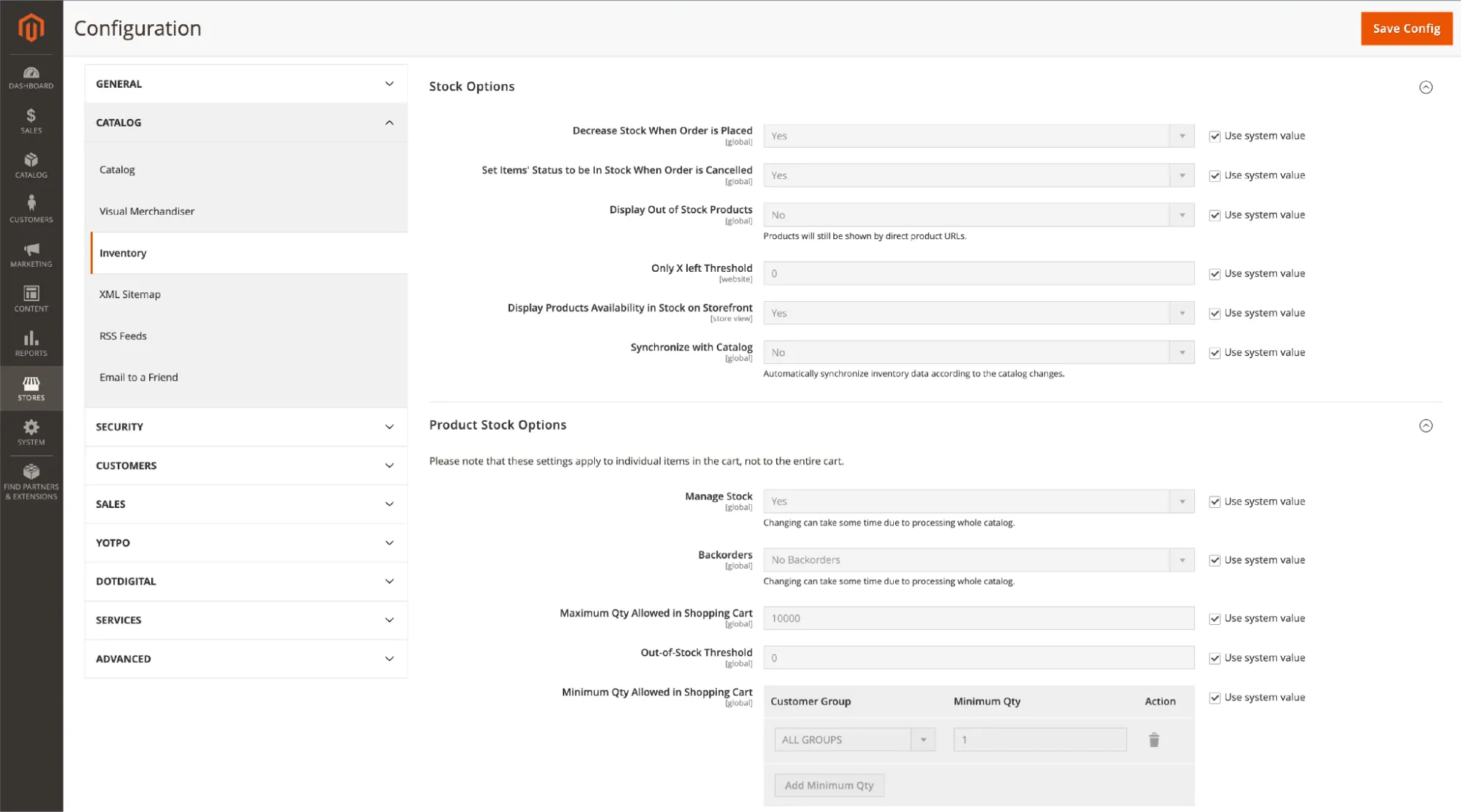
Meanwhile, unlike Magento, OpenCart is still lacking built-in inventory management features. Still, the platform makes up for that with over 90 extensions specifically designed for inventory; two of the standout options that we recommend are Green Inventory and Stock Inventory Report:
- Green Inventory is an all-encompassing solution that covers multiple facets of inventory management. It can organize suppliers, handle purchase orders (both product-based and supplier-based) and manage returns.
- Stock Inventory Report allows you to filter products by name, category, price, model, and quantity or sort them in ascending or descending order. Plus, there's the option to export inventory data into Excel files for easier tracking.
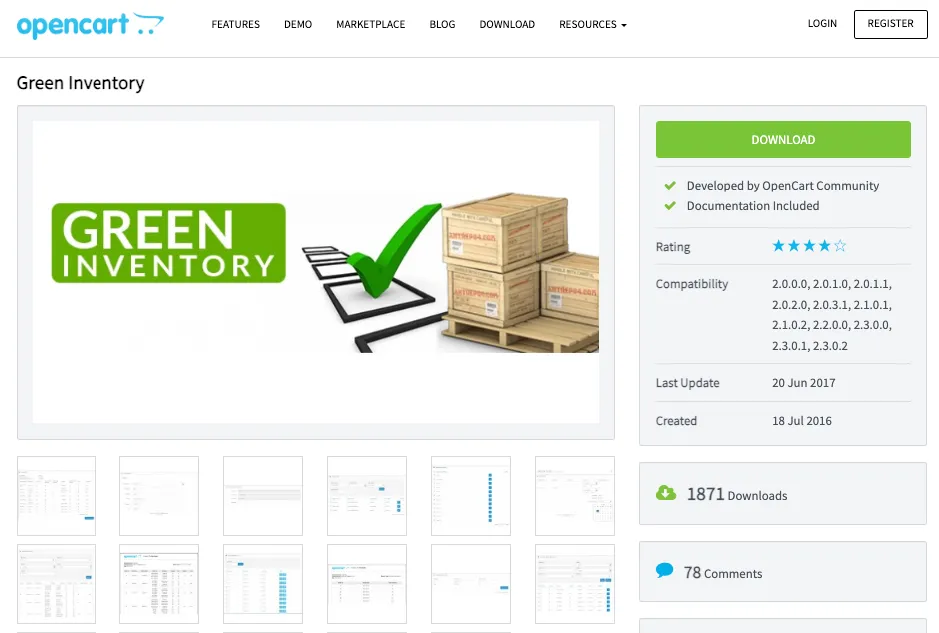
Payment
Currently, Magento includes only PayPal and Braintree as its default payment gateways. For more options, you must expand payment methods via Magento Connect or use extra extensions!
On the brighter side, Magento's multi-currency feature (displaying prices in various currencies) is 100% built-in, and no third-party plugins are needed. This is quite ideal if you want to reach global customers right after launching without all the technical hassles.
Meanwhile, OpenCart provides excellent flexibility right from the start with nearly 36 built-in payment methods, such as PayPal, Rapyd, Stripe, and Square. Better yet, you can totally add more methods to your store via extensions and plugins if desired!
However, one small catch is that OpenCart still lacks a built-in multi-currency feature. Hence, unlike Magento (which integrates multi-currency by default), you'll need to rely on a third-party extension to set up this function for OpenCart.
Shipping settings
All in all, Magento's shipping settings are comprehensive and highly customizable. Without installing any third-party extension or service, you can already set up the following using just Magento's built-in features:
- Flat rate: With this option, you can set a fixed shipping per item (regardless of size or weight) to simplify cost management and ensure customers can easily predict their shipping expenses.
- Point of origin: It determines where the shipment is sent from (whether a store or warehouse) and factors in tax rates to ensure accurate pricing.
- Shipping policy: Here's where you can set clear customer expectations, such as outlining minimum order values for free shipping or international deliveries.
- Multiple addresses: Your customers may ship items to different addresses within a single order – quite helpful for bulk purchases or gift-giving. You can also define the maximum number of addresses for each order.
- Free shipping: As the name suggests, the free shipping feature will be triggered when certain conditions (e.g., minimum purchase amount) are met. As a result, it can encourage customers to keep buying in order to reach specific order thresholds and enjoy free delivery.
How about OpenCart? The platform also provides built-in tools for shipping management, though they are more basic compared to Magento. These core settings allow you to configure the following:
- Cost: The flat rate for shipping
- Tax class: Taxes applied based on the product type (complying with tax rules)
- Geo zone: Specific zones assigned where flat-rate shipping is offered (useful for tailoring shipping options to different regions or countries.)
- Status: The option to enable or disable a specific shipping method so you can adjust your offerings as needed
- Sort order: Arranging the display of different shipping methods during checkout to improve customer's experience
Aside from these options, OpenCart still relies heavily on extensions for more advanced shipping choices. For instance, to set up a “Pickup from Store” option, you'll need to navigate to “Extensions” > “Shipping” to install the appropriate module.
The Verdict
Between OpenCart vs Magento, Magento clearly takes the crown. Its rich, fairly comprehensive built-in features allow users to launch their eCommerce stores right away without hiccups! OpenCart's excessive reliance on extensions, on the other hand, might confuse and overwhelm some merchants during the early stages.
OpenCart vs Magento 2 Themes (OpenCart wins)
A well-organized store is just the beginning; you also need a visually stunning and captivating design to attract customers! That's where OpenCart vs Magento themes come into play, and we've gone all in to discover how both platforms truly stack up when it comes to this criterion:
OpenCart themes
As of our writing, OpenCart offers a comprehensive collection of 1,872 themes (351 free and 1,521 paid; the latter costs around $20/theme on average). And to simplify your search even more, the platform introduces 5 filters:
- Recently updated: Themes that have received the latest improvements and updates to stay compatible with current OpenCart features
- Recently added: The newest themes added to the collection
- Name: Organizing the themes alphabetically
- Price: Exploring different themes based on the budget (descending or ascending orders)
- Rating: Sorting themes based on user feedback and scores (0 stars to 5 stars).
Even better, since each theme includes a live demo, you can preview its design and most of the basic functionalities before making your decision. Feel free to use the Theme Editor to adjust the header, color, fonts, and more until they match your style!
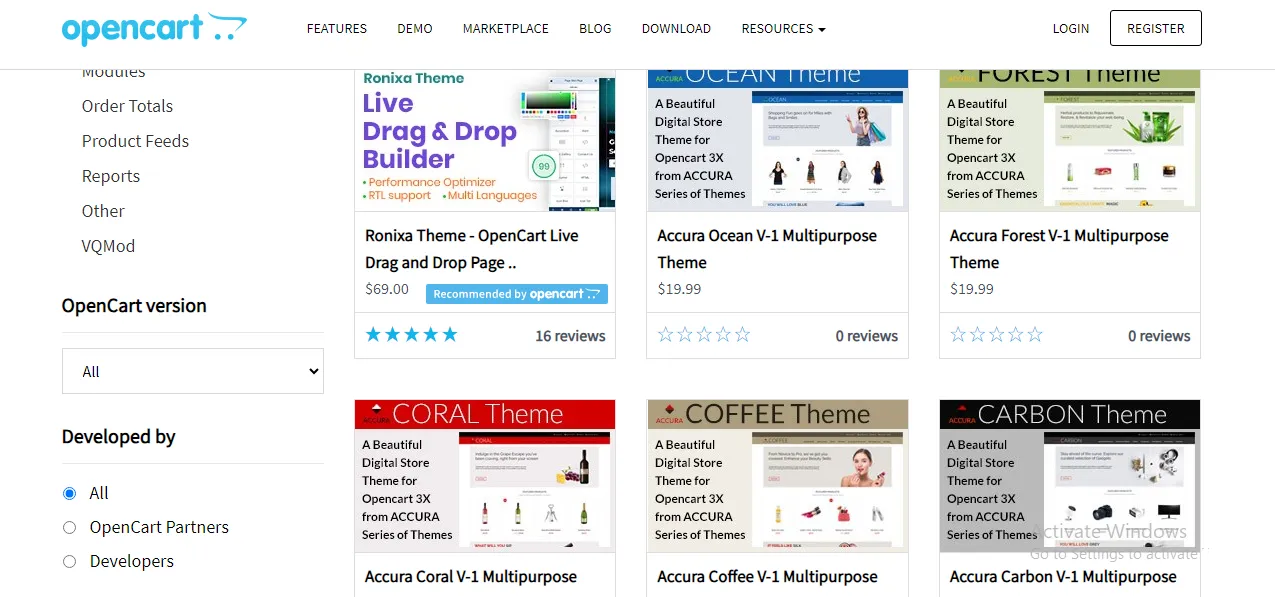
Magento themes
So far, Magento's theme collection is quite limited. It has 11 themes – 3 free and 8 paid (from $25 to $499, much more expensive than OpenCart and other platforms). There are three additional filters to make browsing easier:
- Relevance: Themes are sorted by how closely they match your search or browsing behavior.
- Price: Themes displayed from highest to lowest price (or vice versa) to help you focus on what fits your budget
- Rating: Sorting themes based on user reviews, with higher-rated themes appearing first.
The thumbnail images for all the themes are quite small, so you might struggle to visualize their full potential when scrolling through the collection at first glance. Fortunately, once you click on a specific theme, live demos will be available to help you confirm exactly what you're getting before making your purchase.
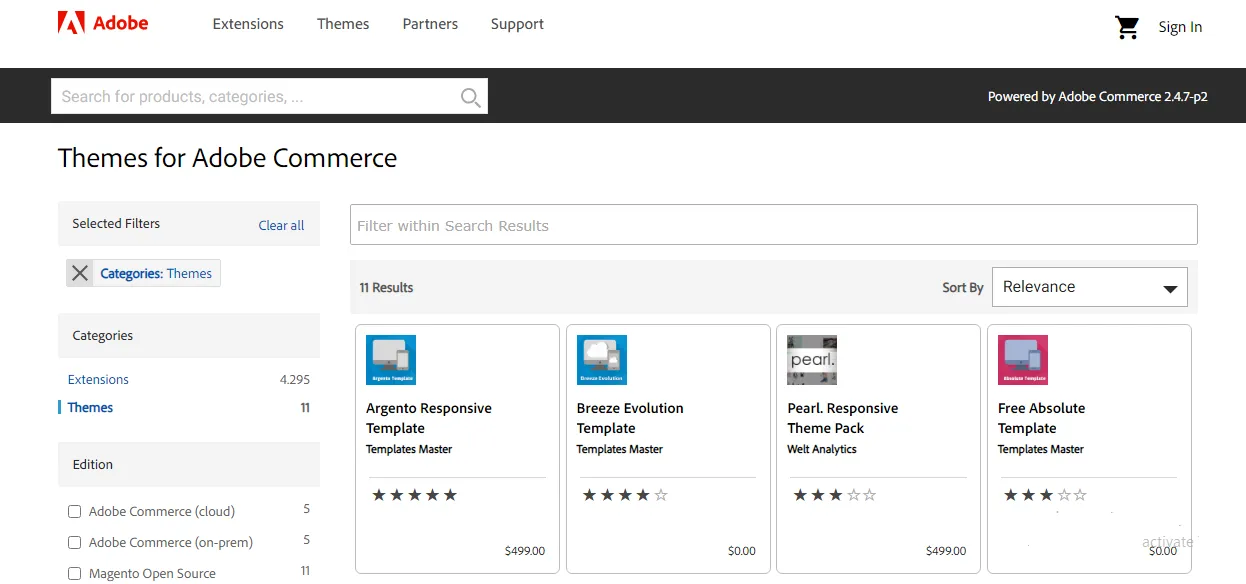
The Verdict
OpenCart easily pulls ahead in this OpenCart vs Magento battle with nearly 1,900 theme options. Meanwhile, Magento's modest collection of just 11 themes (many of which come with a hefty price tag) falls short in comparison.
OpenCart vs Magento Extensions (OpenCart wins)
Beyond the core features, most eCommerce merchants look to grow their stores even further as customer expectations evolve over the years. To meet those rising demands, both OpenCart and Magento offer extension stores packed with extra tools to boost functionality! While we’ve touched on a few extensions earlier, now is the time to dig a little bit deeper.
OpenCart extensions
We can say OpenCart's collection is very comprehensive. It offers more than 13,000 options, many of which are 100% free to help you boost your store's functionality without breaking the bank!
Navigating through such a large selection might be quite overwhelming for beginners, though OpenCart does offer a filtering system to make it a bit easier. Aside from the standard filters mentioned in our OpenCart themes discussion (Recently Updated, Recently Added, Name, Price, and Rating), there are also extra filters and groups as follows:
- Categories: Extensions neatly organized by topics, such as Languages, Shipping methods, Payment gateways, Orders total, and more
- OpenCart versions: Displayed to help you find extensions compatible with your store's current version, from 1.4 to the latest 3.0
- Creators: You can select from extensions created by either the OpenCart community (Developers) or by official OpenCart partners.
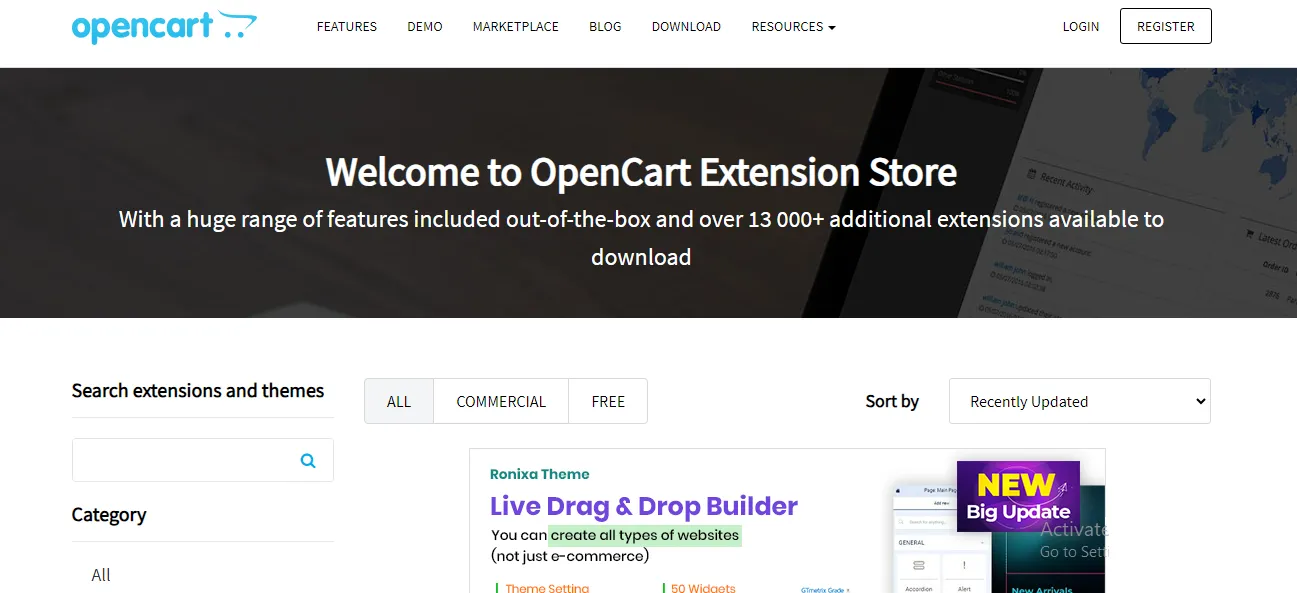
Magento extensions
Currently, Magento's extension library offers over 4200 extensions, many of which are free to let you explore options without the pressure of upfront costs.
There is also a robust filtering system to simplify browsing, just like with OpenCart. Beyond the basic filters like Relevance, Price, and Rating, Magento allows you to dig deeper using:
- Categories: You can filter by specific topics such as Marketing, Payments, Sales, Shipping, etc.
- Assured extensions: Extensions under this label have been rigorously verified for quality
- Edition: You may select extensions that specifically cater to Magento Open Source (the focus of this article) or opt for ones that align with the paid versions of Magento.
- Partner types: Highlighting whether the extensions are developed by Adobe Gold or Platinum partners
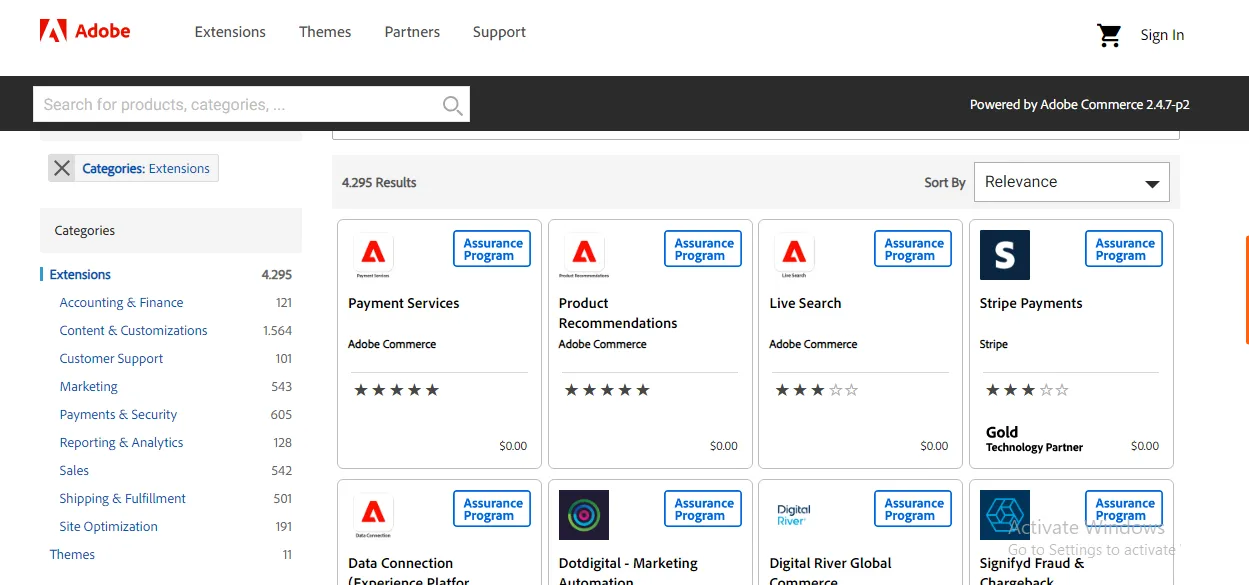
The Verdict
OpenCart vs Magento both offer extensive extension collections with powerful filtering systems. Still, the numbers speak for themselves. With over 13,000 extensions compared to Magento's 4,200+, OpenCart clearly takes the lead in this category.
SEO & Marketing Tools (Magento wins)
Your store is all set up beautifully, and you have configured all the necessary selling features. Now, here comes the probably hardest part: making your store known to people! In this section, we will see how OpenCart vs. Magento helps you in terms of SEO (search engine optimization) and marketing:
OpenCart SEO & Marketing
Regarding SEO, OpenCart allows you to create search-engine-friendly URLs for important pages like products, categories, manufacturers, and information sections. For more advanced features, there are 201 SEO extensions designed to cover additional needs, such as:
- Hiding out-of-stock products without negatively impacting SEO rankings
- Fixing duplicate SEO address errors
- Creating redirects (301, 302, or 307) to guide both search engines and customers to the correct URLs.
- Auto-generating alt-text and titles for images.
On the marketing side, OpenCart offers several built-in tools to help you attract and retain customers. Some key features include:
- Discounts: OpenCart lets you create discounts, coupons, and specials to launch promotions that drive sales. You can also use them to offer limited-time deals or reward loyal customers.
- Affiliates: The platform also includes an Affiliate system, which allows you to partner with affiliates who can promote your products to their audiences. As a result, your reach and sales potential may expand through a wider network of marketers.
- Email: In addition, with OpenCart's mail system, you can send targeted emails and newsletters to specific customer groups (categorized based on preferences or purchase behaviors) to keep them engaged.
Still want more? Remember that aside from these core tools, there are still 55 marketing extensions ($0 to $99) available to further optimize your marketing strategies.

Magento SEO & Marketing
When it comes to SEO settings, Magento provides quite a solid foundation for beginners. Right from the dashboard, you can configure essential elements such as:
- Meta tags for both products and homepages
- SEO-friendly URLs for products and categories
- Adding prefixes and suffixes to your title tags
- Settings for alt-text on images and logos
- Canonical tags (to avoid duplicate content issues) and the site's indexing
For an even deeper insight, Magento integrates with Google Analytics and Google AdWords to offer a complete view of your site's performance. Plus, with almost 400 SEO extensions available ($0 to $399/year), you have full control over how to fine-tune and expand your SEO strategy.
Likewise, Magento's marketing tools are just as comprehensive as its SEO offerings. The platform goes beyond regular promotions to support highly targeted campaigns that speak directly to different customer segments!
- Coupons: You can up promotions with various discount types, usage restrictions, and validity periods to offer exclusive, personalized deals to loyal customers.
- Related products: With just a few clicks, Magento will automatically recommend related products and complementary items at key points in the customer journey to increase sales conversion.
- Wish lists: This feature enables your customers to save items for later and keep them engaged with your store.
- Product reviews: It's a great way to add social proof and give satisfied customers a platform to share their experiences about your brand. New buyers and prospects will likely find you through these channels.
And that's not all there is to it. With 543 marketing extensions available (10 times more than OpenCart) at $0 to $1200/year, scaling campaigns and automating processes on Magento is no longer a headache.
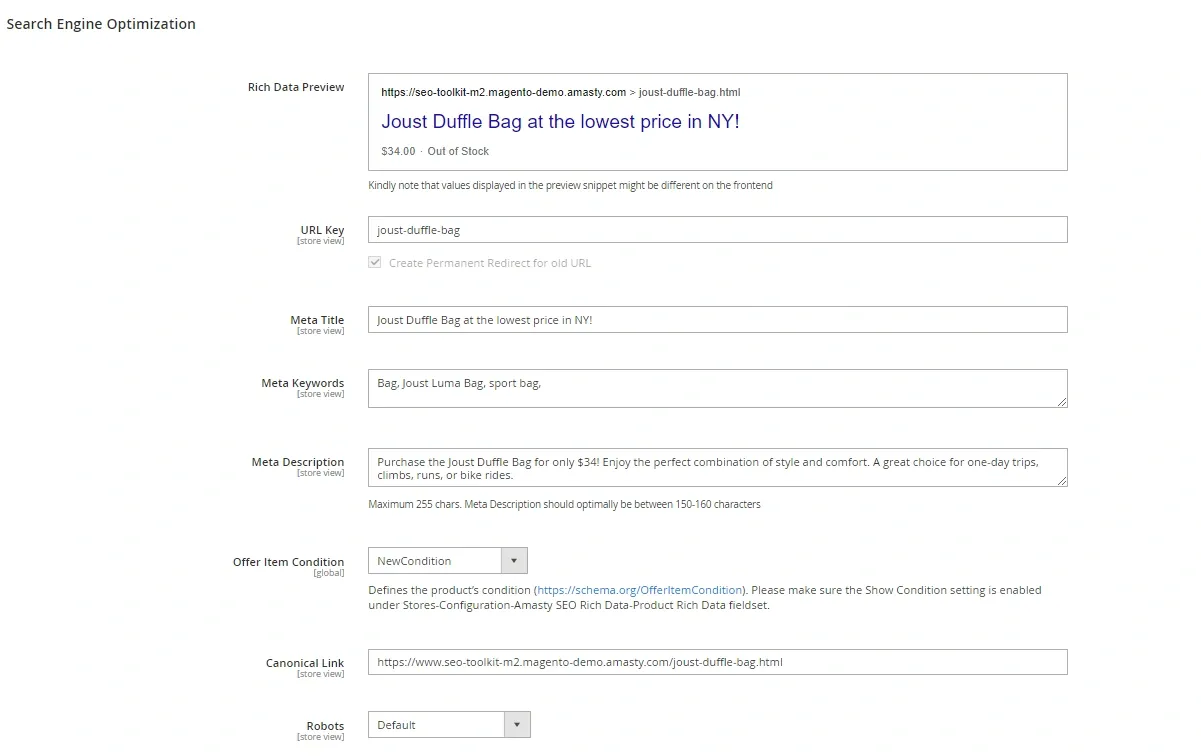
The Verdict
It's a close race between OpenCart vs Magento: both platforms bring solid offerings to the table. Nevertheless, Magento pulls ahead as the winner since its built-in features and extensions are versatile and more inclusive.
Integration Capabilities (A tie)
Aside from the core features of both platforms, you're probably curious about how smoothly OpenCart vs Magento can integrate with other tools or systems. To address this important question, we have made sure to highlight their integration capabilities in our comparison below:
OpenCart integrations
In most systems, data must fit into predefined tables and fields, but OpenCart flips the script! The platform greatly benefits from its schema-less database design, which breaks free from the rigid structures typical of traditional databases. Thanks to this flexibility, it can effortlessly store unstructured or semi-structured data without needing constant adjustments.
In simpler terms, as your product range grows (or your customer base evolves), OpenCart will let you freely add new payment gateways and advanced store options. Integrating with third-party platforms is also a no-brainer.
Magento integrations
Regarding integration capabilities, Magento's powerful API support is quite a game-changer.
With both SOAP (Simple Object Access Protocol) and REST (Representational State Transfer) protocols at your fingertips, you're not limited to just what comes out of the box. You can tailor settings and features – and even integrate third-party tools like CRMs and ERPs – to create a fully customized, high-performing store. Therefore, it's a breeze to scale your store as it grows over time, whether improving efficiency or introducing brand-new features.
The Verdict
Though their approaches differ, both platforms help you scale your store and integrate smoothly with external services. Since we have had quite positive experiences with each, this round is a neck-and-neck tie.
Security (Magento wins)
As eCommerce continues to dominate the world, it's no surprise that online merchants are prime targets of hacking and data theft! In response to that growing threat, we've taken a closer look to see if OpenCart vs Magento can truly safeguard your store for the long haul.
OpenCart security
In all honesty, we must say that OpenCart’s security can be a bit of a concern for users who prioritize protection. Unlike other platforms, it doesn’t offer any notable built-in security features – not to mention the lack of frequent updates and patches. The latest version, 4.0.2.3, was already released over a year ago!
Hence, to bolster security, users must turn to third-party extensions (there are currently 158 available at $0 to $400). Note that since they were developed by different creators for various versions of OpenCart, you have to be very selective during installation. Otherwise, they might end up exposing your site to even more risks.
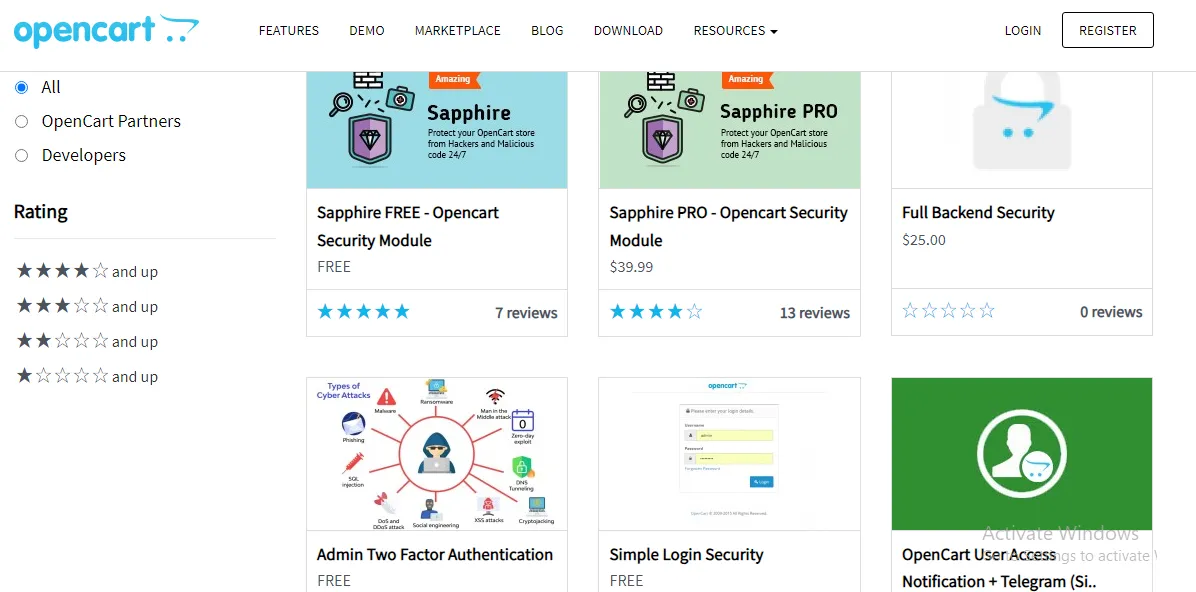
Magento security
On the contrary, Magento places quite a strong emphasis on security. Its core security layer is Content Security Policies (CSP), which help defend against notoriously dangerous attacks such as:
- Cross-site Scripting (XSS)
- Session hijacking
- Clickjacking
- Card skimming.
Even better, you can choose between two different modes for CSP, depending on your needs:
- In “Report-only” mode, CSP monitors potential policy violations but doesn't interfere with the store's operations. We recommend this mode during testing and debugging.
- Meanwhile, the “Restrict” mode offers a stricter approach, where CSP actively blocks every single violation to boost the site's security in real-time.
And that's not all; the platform also rolls out regular updates to address newly discovered vulnerabilities. You can visit the Magento Security Center to stay updated with timely information on recent security patches, severity levels, affected Magento versions, and more.

The Verdict
Magento dominates this Magento vs OpenCart battle with its robust built-in tools. Meanwhile, with OpenCart, security seems more like an afterthought since the platform relies solely on extensions.
Customer Support (OpenCart wins)
No matter how skilled or tech-savvy you are, running a massive eCommerce store without hitting a few bumps along the way is just impossible. That's why you need a reliable support team for those issues – or, at the very least, a comprehensive knowledge base. Between Magento community vs OpenCart, which does better in that regard?
OpenCart customer support
We are quite impressed that OpenCart goes the extra mile to ensure users have a variety of reliable support options at their fingertips. You can choose between the following methods to reach out to their team:
- Email support: For quick inquiries, you can send an email to [email protected]. The team is available daily from 09:30 to 18:30.
- Support tickets: What if your issue requires more detailed attention? In that case, you can open a support ticket. The staff will be available from Monday to Friday, 8 am to 5 pm.
- Dedicated support (Paid service): Regarding technical needs (such as password resets, store backups, etc.), OpenCart provides dedicated support at an additional cost.
In addition to these direct support methods, the platform also introduces well-documented guides and an active community forum. Both provide you plenty of space to troubleshoot common issues on your own without needing to contact OpenCart's team!
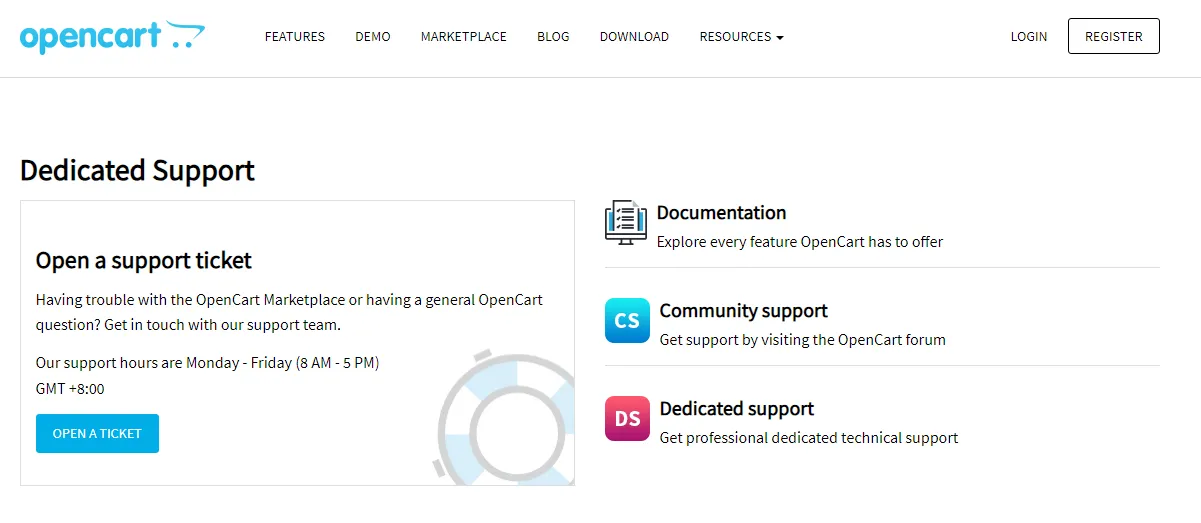
Magento customer support
From our own experience, Magento stands out for its well-structured and extensive knowledge base. This resource offers thousands of detailed guides organized into clear categories, such as:
- Best Practices
- How-To
- Troubleshooting
- FAQs
- Tech Resources
- Developer Documentation.

Unsure which category your issue belongs to? There's a search bar for that! You just need to enter a keyword and easily browse through relevant results. Plus, the community forum is very active, so you can always turn to fellow members for advice and support whenever you need it.
On the other hand, direct human support is where Magento falls a bit short. Users are limited to contacting support via telephone (1-800-685-3624) or email ([email protected]). Neither option provides clear information about response times or hours of availability.
The Verdict
Magento’s knowledge base is undoubtedly very impressive. Still, thanks to its wider range of direct human support, OpenCart totally steals the spotlight in this OpenCart vs Magento battle.
Who Should Use OpenCart vs Magento?
While OpenCart may come out on top overall, that doesn't mean it's always the perfect fit for every business. (Magento did surpass OpenCart in several key areas, after all!). So, to wrap up today's discussion, let's explore which types of businesses are best suited for each platform.
Who should use OpenCart?
Is OpenCart any good? Obviously yes. Overall, it is an amazing choice for:
- Businesses prioritizing simplicity: Are you a non-tech savvy owner looking for a simple, easy-to-use platform? Then, OpenCart is a great choice since it barely requires technical know-how for both installation and management.
- Companies needing cost-efficiency: OpenCart's overall lower costs (free platform, lower hosting costs, cheaper themes) make it ideal for businesses with tight budgets. Its extensions are also very affordable, meaning you can scale at your own pace without heavy upfront investment.
- Businesses with basic inventory needs: As mentioned above, OpenCart lacks built-in inventory management (though it does provide access to over 90 extensions). We highly recommend it for small/medium-sized retailers with limited inventory or simpler product lines.
Who should use Magento?
On the other hand, Magento is a fitting solution for:
- Large enterprises: Extensive customization options and the ability to handle large product catalogs are Magento's biggest selling points. It's the perfect platform for large enterprises with high-volume sales and complex product offerings.
- Global eCommerce businesses: Thanks to the built-in multi-currency support and advanced shipping features, Magento can help your business operate efficiently on a global scale.
- Companies focused on advanced SEO and marketing: Want to fine-tune your SEO and marketing strategies for better visibility? Magento provides built-in SEO tools and over 500 marketing extensions for that.
FAQs
Which is better, Magento or OpenCart?
Both OpenCart vs Magento have their merits, but OpenCart truly shines with its incredibly user-friendly interface, an impressive collection of extensions, and excellent customer support.
Is OpenCart still relevant?
Without a doubt, OpenCart is still going strong! With over 880,000 active websites, it easily surpasses Magento (660,000+ websites) and many other eCommerce platforms in popularity.
Do people still use Magento?
Absolutely! Its robust features for eCommerce, marketing, and security keep it at the top of the game, even though the initial setup might feel a bit daunting at first.
Final Words
In this head-to-head between OpenCart vs Magento, OpenCart emerges victorious with its superior extension collection, high-performance hosting, and intuitive design. After all, over 880,000 website owners trust this platform for a good reason!
So if you're looking to future-proof your current business, now's the perfect time to make the switch with LitExtension OpenCart Migration. With 12 years of experience and over 200,000 happy customers globally, we can totally take your migration journey to the next level!
For more information, check out our eCommerce guides and join our Facebook Community.

